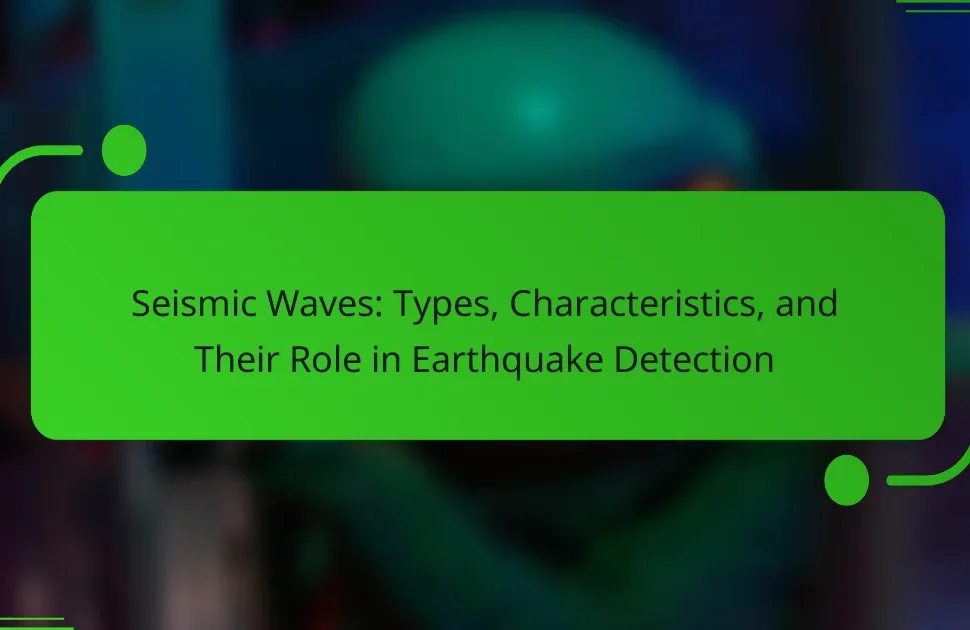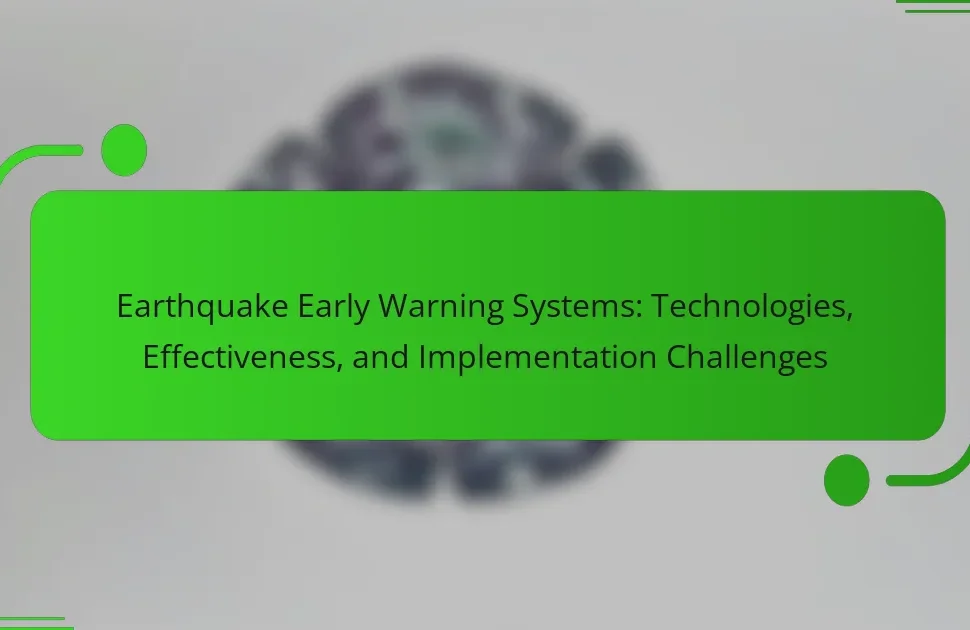Plate tectonics is a scientific theory that explains the movement of Earth’s lithosphere, which consists of rigid plates floating on the semi-fluid asthenosphere. The article outlines the types of plate movements, including divergent, convergent, and transform boundaries, and their geological implications, such as the formation of new crust, subduction zones, and fault lines. It also highlights the connection between plate tectonics and earthquakes, detailing how stress at plate boundaries leads to seismic activity. The significance of understanding plate tectonics is emphasized, particularly in relation to predicting earthquakes, with a focus on the Pacific Ring of Fire as a major area of tectonic activity.
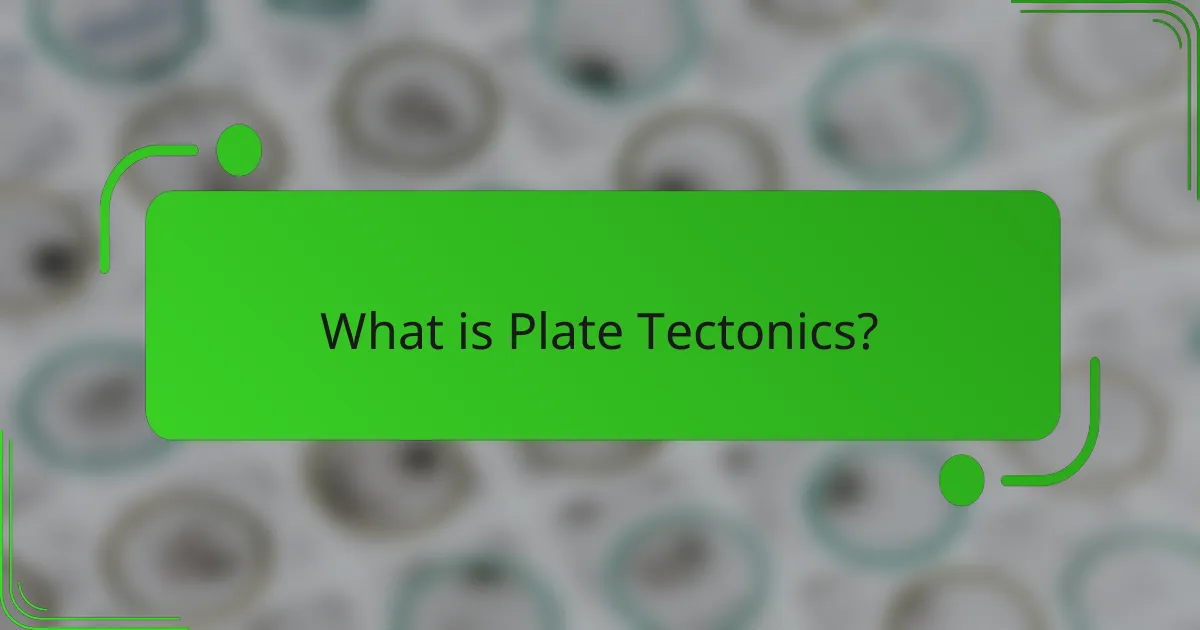
What is Plate Tectonics?
Plate tectonics is the scientific theory explaining the movement of Earth’s lithosphere. The lithosphere consists of rigid plates that float on the semi-fluid asthenosphere beneath. These plates interact at their boundaries, leading to geological phenomena. The theory was developed in the mid-20th century, supported by evidence like continental drift and seafloor spreading. Key movements include divergent, convergent, and transform boundaries. Earthquakes and volcanic activity often occur at these boundaries. The theory has transformed our understanding of geological processes and Earth’s history.
How did the theory of Plate Tectonics develop?
The theory of Plate Tectonics developed through a series of scientific advancements. In the early 20th century, Alfred Wegener proposed the idea of continental drift. He suggested that continents were once connected and have since moved apart. His theory lacked a mechanism, limiting its acceptance.
In the 1960s, advancements in oceanography revealed mid-ocean ridges. These ridges indicated seafloor spreading, providing evidence for tectonic movement. Researchers like Harry Hess contributed to this understanding. Additionally, paleomagnetic studies showed that continents had shifted over time.
The combination of these findings led to the acceptance of Plate Tectonics as a unifying theory. It explained not only continental movement but also the occurrence of earthquakes and volcanic activity. The theory is now foundational in geology, supported by extensive research and data.
What historical events contributed to the formation of the theory?
The theory of plate tectonics was shaped by several key historical events. The concept began with Alfred Wegener’s 1912 proposal of continental drift. His observations of similar fossils across continents provided early evidence. In the 1940s and 1950s, advancements in oceanography revealed mid-ocean ridges. These ridges indicated seafloor spreading, supporting Wegener’s ideas. The discovery of paleomagnetism in the 1960s further solidified the theory. It showed that Earth’s magnetic field has reversed, allowing scientists to trace plate movements. The combination of these events led to the comprehensive understanding of plate tectonics. Each event contributed crucial evidence that built the foundation of the theory.
Who were the key scientists involved in the development of Plate Tectonics?
Alfred Wegener, Harry Hess, and John Tuzo Wilson were key scientists in the development of Plate Tectonics. Alfred Wegener proposed the theory of continental drift in 1912. His ideas laid the groundwork for later developments in plate tectonics. Harry Hess introduced the concept of seafloor spreading in the early 1960s. His research provided a mechanism for Wegener’s earlier theories. John Tuzo Wilson contributed with the concept of transform faults in 1965. He also helped integrate various geological observations into the plate tectonics framework. These scientists collectively advanced our understanding of Earth’s tectonic processes. Their contributions were fundamental to establishing plate tectonics as a unifying theory in geology.
What are the fundamental concepts of Plate Tectonics?
Plate tectonics is the scientific theory explaining the movement of Earth’s lithosphere. This movement occurs due to the convection currents in the mantle. The lithosphere is divided into several tectonic plates. These plates float on the semi-fluid asthenosphere beneath them. Interactions between these plates lead to geological phenomena. There are three main types of plate boundaries: convergent, divergent, and transform. Convergent boundaries occur when plates collide, often forming mountains or causing subduction. Divergent boundaries happen when plates move apart, creating new crust. Transform boundaries occur when plates slide past each other, leading to earthquakes. The theory of plate tectonics also explains the distribution of earthquakes and volcanoes around the globe.
What are tectonic plates and their characteristics?
Tectonic plates are large, rigid pieces of the Earth’s lithosphere. They float on the semi-fluid asthenosphere beneath them. These plates vary in size and shape, with the Pacific Plate being the largest. Tectonic plates are characterized by their movement, which can be divergent, convergent, or transform. Divergent boundaries occur where plates move apart, creating new crust. Convergent boundaries occur where plates collide, leading to subduction or mountain formation. Transform boundaries occur where plates slide past each other, causing earthquakes. The interactions at these boundaries are responsible for seismic activity and geological features.
How do the layers of the Earth relate to Plate Tectonics?
The layers of the Earth directly influence Plate Tectonics. The Earth’s structure consists of the crust, mantle, outer core, and inner core. The lithosphere, which includes the crust and the uppermost part of the mantle, is rigid and divided into tectonic plates. These plates float on the semi-fluid asthenosphere, a layer within the upper mantle.
The movement of the tectonic plates is driven by convection currents in the mantle. These currents occur due to the heat from the Earth’s core. The interactions between plates can lead to various geological phenomena, including earthquakes and volcanic activity. For example, when plates collide, they can create mountains or cause earthquakes.
The relationship between the Earth’s layers and Plate Tectonics is fundamental to understanding geological processes. Studies show that the dynamics of the mantle significantly impact plate movements. Thus, the structure and behavior of the Earth’s layers are essential for the theory of Plate Tectonics.
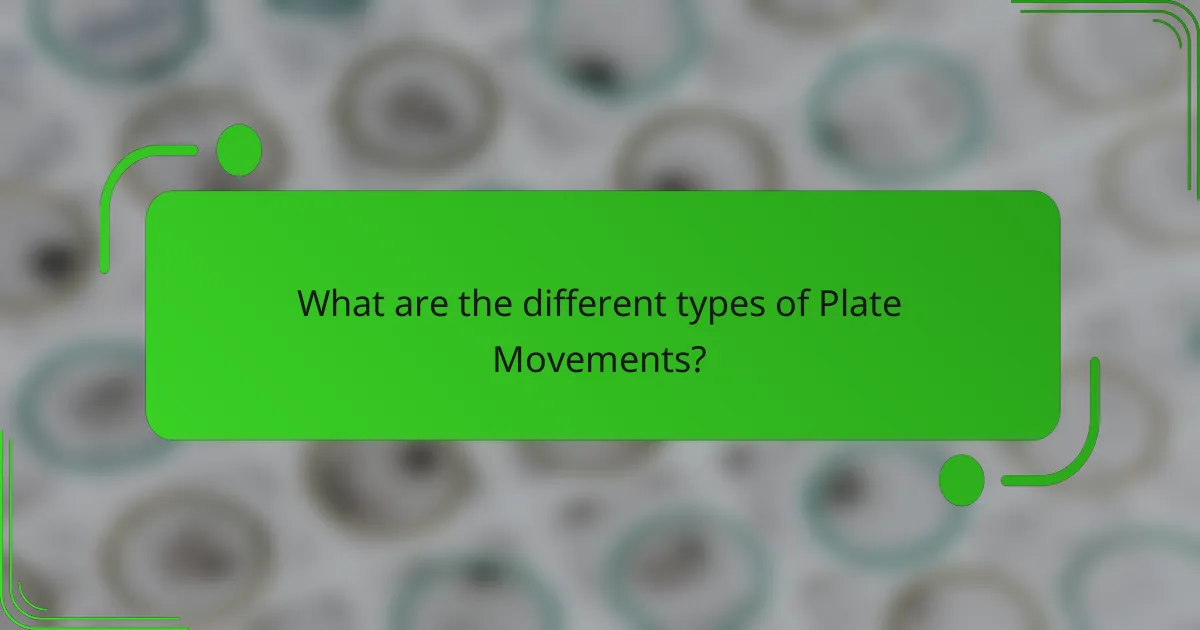
What are the different types of Plate Movements?
The different types of plate movements are divergent, convergent, and transform. Divergent movements occur when tectonic plates move apart. This movement creates new crust as magma rises to the surface. An example is the Mid-Atlantic Ridge. Convergent movements happen when plates collide. This can result in one plate being forced beneath another, leading to subduction zones. The Himalayas are a result of such movements. Transform movements involve plates sliding past each other. This lateral movement can cause earthquakes along fault lines. The San Andreas Fault is a well-known example of transform movement. Each type of movement plays a crucial role in shaping the Earth’s surface.
What are the three main types of plate boundaries?
The three main types of plate boundaries are divergent, convergent, and transform boundaries. Divergent boundaries occur where two tectonic plates move apart. This movement creates new crust as magma rises to the surface. Convergent boundaries form where two plates collide. This can result in one plate being forced beneath another, leading to subduction zones. Transform boundaries occur where plates slide past one another horizontally. This lateral movement can cause earthquakes along fault lines. Each boundary type is associated with specific geological features and activities, such as earthquakes and volcanic activity.
How do divergent boundaries function?
Divergent boundaries function by allowing tectonic plates to move apart from each other. This movement occurs due to convection currents in the Earth’s mantle. As the plates separate, magma rises from below the Earth’s crust. The magma cools and solidifies, forming new crust. This process is evident at mid-ocean ridges, where new ocean floor is created. The formation of rift valleys is another example of divergent boundaries on land. Geological evidence shows that these boundaries are associated with volcanic activity and earthquakes. Studies indicate that divergent boundaries contribute to the dynamic nature of the Earth’s surface.
What occurs at convergent boundaries?
At convergent boundaries, tectonic plates collide with each other. This collision can lead to the subduction of one plate beneath another. Subduction zones are often associated with intense geological activity. Earthquakes frequently occur in these regions due to the stress from the colliding plates. Additionally, volcanic activity is common at convergent boundaries. The melting of the subducted plate can create magma, leading to eruptions. Mountain ranges can also form as a result of this collision. The Himalayas, for example, were formed by the collision of the Indian and Eurasian plates.
What are transform boundaries and their significance?
Transform boundaries are tectonic plate boundaries where two plates slide past one another. This lateral movement can cause significant geological activity. The friction between the sliding plates often leads to earthquakes. Notable examples include the San Andreas Fault in California. Transform boundaries are significant as they are sites of intense seismic activity. They shape the landscape and contribute to the formation of faults. Understanding these boundaries helps in predicting earthquake occurrences. This knowledge is crucial for disaster preparedness and risk mitigation.
How do these movements affect the Earth’s surface?
Plate tectonic movements significantly affect the Earth’s surface. These movements can lead to the formation of mountains, valleys, and ocean trenches. For example, the collision of tectonic plates can create mountain ranges like the Himalayas. Divergent boundaries result in rift valleys and mid-ocean ridges. Transform boundaries can cause earthquakes, which reshape the landscape. The movement of plates also influences volcanic activity, leading to the eruption of volcanoes. Over geological time, these processes continuously reshape the Earth’s surface. According to the U.S. Geological Survey, tectonic activity is responsible for many of the Earth’s geological features.
What geological features are formed by plate movements?
Plate movements form several geological features. These include mountains, valleys, and oceanic trenches. Mountains arise from the collision of tectonic plates. This process is known as orogeny. Valleys often form in rift zones where plates pull apart. Oceanic trenches are created at convergent boundaries. They occur when one plate subducts beneath another. Additionally, volcanic islands can form from the rising magma at divergent boundaries. These features illustrate the dynamic nature of Earth’s crust due to plate tectonics.
How do plate movements influence natural disasters?
Plate movements significantly influence natural disasters such as earthquakes and volcanic eruptions. The Earth’s lithosphere is divided into tectonic plates that constantly move. These movements can cause stress to build up along fault lines. When the stress exceeds the strength of the rocks, it results in an earthquake. For instance, the 2011 Tōhoku earthquake occurred due to the subduction of the Pacific Plate beneath the North American Plate. Similarly, volcanic eruptions often happen at plate boundaries where magma can escape to the surface. The interaction of tectonic plates can also trigger tsunamis, as seen after the 2004 Indian Ocean earthquake. Thus, the dynamics of plate tectonics are directly linked to the occurrence of various natural disasters.
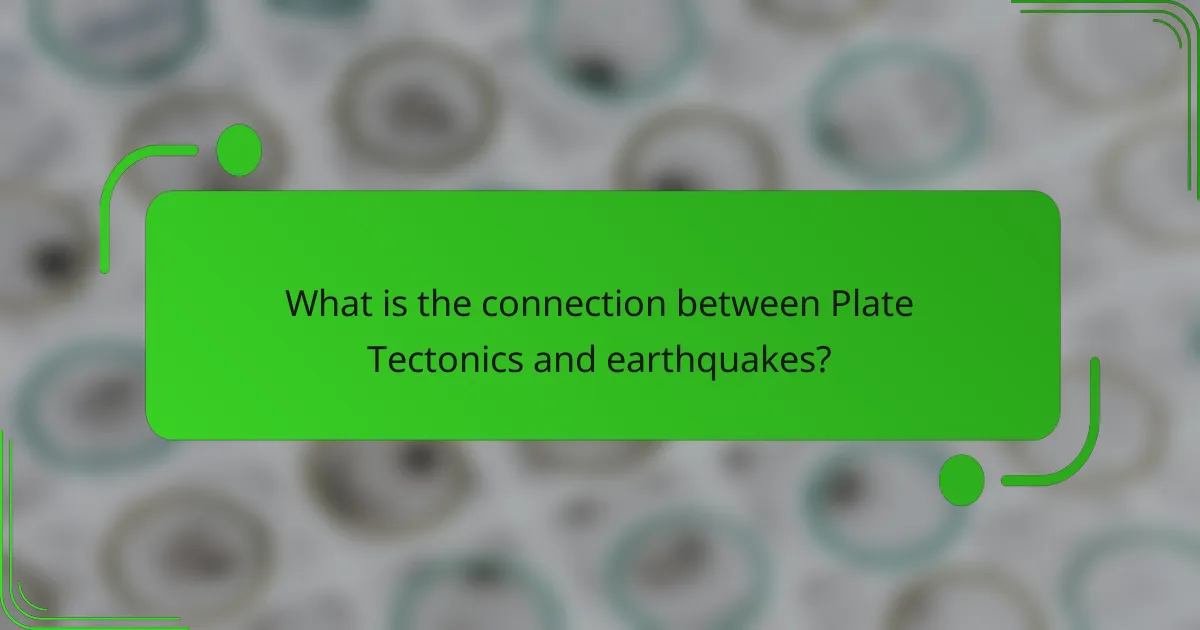
What is the connection between Plate Tectonics and earthquakes?
Plate tectonics is directly connected to earthquakes through the movement of tectonic plates. These plates float on the semi-fluid asthenosphere beneath them. When plates interact at their boundaries, stress builds up due to friction. Eventually, this stress is released as seismic energy, resulting in an earthquake. Most earthquakes occur along plate boundaries, specifically at convergent, divergent, and transform boundaries. Historical data shows that approximately 90% of earthquakes happen in the Pacific Ring of Fire, an area known for its tectonic activity. This relationship highlights the importance of understanding plate tectonics for predicting and studying earthquakes.
How do tectonic plate movements generate earthquakes?
Tectonic plate movements generate earthquakes through the release of stress accumulated along faults. When tectonic plates interact, they can either collide, pull apart, or slide past each other. This interaction creates friction and stress at the edges of the plates. Eventually, the stress overcomes the friction, causing a sudden slip along a fault line. This slip releases energy in the form of seismic waves, which we perceive as an earthquake. For example, the 1906 San Francisco earthquake occurred due to the movement of the Pacific and North American plates along the San Andreas Fault. This process is a fundamental aspect of plate tectonics and is responsible for many of the world’s earthquakes.
What role do fault lines play in earthquake occurrence?
Fault lines are fractures in the Earth’s crust where tectonic plates meet. They play a crucial role in earthquake occurrence by serving as zones of stress accumulation. When stress exceeds the friction along the fault line, it results in a sudden release of energy. This release generates seismic waves, causing an earthquake. The magnitude of the earthquake is influenced by the amount of accumulated stress and the properties of the fault. Major fault lines, such as the San Andreas Fault, have a history of significant seismic activity. Historical records show that earthquakes tend to cluster along these fault lines, confirming their role in earthquake generation.
How does the magnitude of an earthquake relate to plate movements?
The magnitude of an earthquake is directly related to the amount of stress released during plate movements. When tectonic plates shift, they accumulate stress over time. This stress is released suddenly, causing an earthquake. The magnitude measures the energy released, often quantified on the Richter or Moment Magnitude scales. Larger earthquakes occur when significant stress accumulates and is released, typically at plate boundaries. For instance, the 2011 Tōhoku earthquake had a magnitude of 9.0, resulting from the subduction of the Pacific Plate beneath the North American Plate. This relationship underscores the connection between tectonic activity and earthquake magnitude.
What are the different types of earthquakes associated with Plate Tectonics?
The different types of earthquakes associated with plate tectonics include interplate earthquakes and intraplate earthquakes. Interplate earthquakes occur at the boundaries between tectonic plates. These earthquakes are often caused by the movement of plates sliding past, colliding, or pulling apart from each other. Intrplate earthquakes occur within a tectonic plate, away from plate boundaries. These can result from stress accumulation in the plate itself. The majority of significant earthquakes occur along plate boundaries, where stress is released. For example, the 2011 Tōhoku earthquake in Japan was an interplate earthquake. In contrast, the 1811–1812 New Madrid earthquakes in the United States were intraplate events.
What is a shallow-focus earthquake?
A shallow-focus earthquake is an earthquake that occurs at a depth of less than 70 kilometers beneath the Earth’s surface. These earthquakes are typically associated with tectonic plate boundaries. They often result from the movement of the Earth’s crust. Shallow-focus earthquakes tend to cause significant damage due to their proximity to the surface. According to the United States Geological Survey (USGS), most earthquakes are shallow-focus. This type of earthquake can be detected by seismographs, which measure ground motion. The impact of shallow-focus earthquakes is generally felt over larger areas compared to deeper earthquakes.
How does a deep-focus earthquake differ from other types?
A deep-focus earthquake occurs at depths greater than 300 kilometers within the Earth’s crust. This distinguishes it from shallow-focus earthquakes, which occur at depths less than 70 kilometers. Deep-focus earthquakes are typically associated with subduction zones, where one tectonic plate is forced beneath another. In contrast, shallow-focus earthquakes can occur in various tectonic settings, including transform and divergent boundaries. The mechanism of deep-focus earthquakes involves the movement of rocks under high pressure and temperature conditions. This results in different seismic wave characteristics compared to shallower earthquakes. Research indicates that deep-focus earthquakes are less frequent but can release significant energy. The 2011 Tōhoku earthquake is an example of a deep-focus event that had widespread impacts.
What precautions can be taken to mitigate earthquake risks?
To mitigate earthquake risks, individuals and communities should adopt several precautions. First, building structures to meet seismic codes is essential. These codes ensure buildings can withstand seismic forces. Second, retrofitting older buildings enhances their ability to endure earthquakes. This process involves reinforcing walls and foundations. Third, creating an emergency plan is crucial for households and businesses. This plan should include evacuation routes and communication strategies. Fourth, securing heavy furniture and appliances prevents them from toppling during an earthquake. Fifth, conducting regular earthquake drills prepares individuals for real situations. Lastly, staying informed about local seismic activity helps communities respond effectively. These precautions collectively reduce the impact of earthquakes on lives and property.
How can individuals prepare for earthquakes?
Individuals can prepare for earthquakes by creating an emergency plan. This plan should include designated meeting spots and communication methods. Individuals should also assemble an emergency kit with essential supplies. The kit should contain water, non-perishable food, a flashlight, and a first-aid kit. Securing heavy furniture and appliances can prevent injuries during an earthquake. Regularly practicing earthquake drills helps individuals respond effectively. Staying informed about local seismic activity enhances preparedness. Research indicates that communities with preparedness plans experience less damage and quicker recovery.
What structural designs are effective in earthquake-prone areas?
Reinforced concrete structures are effective in earthquake-prone areas. These designs incorporate steel bars to enhance tensile strength. Base isolators allow buildings to move independently of ground motion. Shear walls provide lateral stability during seismic activity. Cross-bracing techniques distribute forces evenly across structures. Moment-resisting frames allow buildings to flex without collapsing. The use of lightweight materials reduces overall mass, minimizing earthquake impact. These designs are supported by engineering standards and have proven effective in real-world applications, such as the 2011 Japan earthquake.
Plate tectonics is the scientific theory explaining the movement of Earth’s lithosphere, consisting of rigid plates that float on the semi-fluid asthenosphere. The article covers the development of this theory, key scientists involved, and the fundamental concepts of plate movements, including divergent, convergent, and transform boundaries. It discusses how these movements shape the Earth’s surface and their connection to natural disasters such as earthquakes and volcanic activity. Additionally, the article outlines the types of earthquakes associated with plate tectonics and precautions individuals can take to mitigate earthquake risks.

